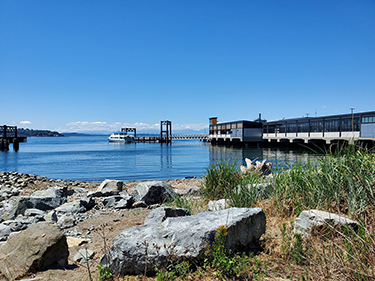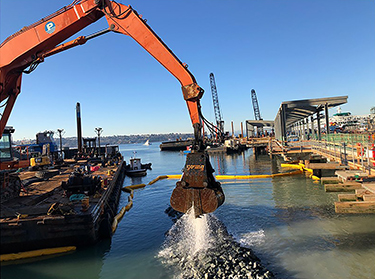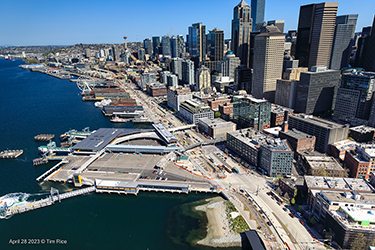|
Subscribe / Renew |
|
|
Contact Us |
|
| ► Subscribe to our Free Weekly Newsletter | |
| home | Welcome, sign in or click here to subscribe. | login |
Architecture & Engineering
| |
July 3, 2023
Man-made habitat beach opens at Seattle waterfront
Visitors to the Seattle waterfront have a new place to sit, watch ferries go by, and immerse themselves in the natural beauty of the Puget Sound following the opening of a new habitat beach on Saturday.
The beach, which is officially titled the Pioneer Square Habitat Beach, is a new man-made intertidal area between Colman Dock and Pier 48, adjacent to the historic Washington Street Boat Landing pergola.
It was developed by the city's Office of the Waterfront and Civic Projects as part of the blockbuster $781 million renovation and rehabilitation of the waterfront that began in 2010. Habitat Beach is part of the Waterfront Park portion of that development, which will create a new 20-acre that extends along the waterfront from the stadium district and Pioneer Square up to Belltown and includes extensions to the east connecting the waterfront into downtown neighborhoods and the downtown core. The beach was designed by a multidisciplinary team including Parsons, Hart Crowser, Moffatt & Nichol and Anchor QEA. It was built by Pacific Pile & Marine.
Habitat Beach is an attractive new community amenity but was primarily created to support marine habitat along the waterfront. According to a press release from the city, when the existing waterfront was first developed many of the native intertidal elements were lost including sloping beaches, crevices and vegetated hiding places for fish.
Habitat Beach restores some of what was lost. Over 45,000 tons of material, including sand, gravel, soil, shells and rocks of varying sizes make up this new intertidal shoreline. The project also included the planting of ample nearshore vegetation. Plantings were specifically selected to restore the function of a natural shoreline and to improve ecosystem productivity, especially juvenile salmon migration. Plantings comprise 1,400 native plants and include evergreen trees, saltwater-tolerant shrubs, shore pines, Oregon grapes, nootka roses, douglas asters, entire-leaved gumweeds, american dunegrasses, and sea plantains.
These marine improvements were created on state-owned property thanks to an agreement between the Washington State Ferries and the city of Seattle.
Habitat Beach was actually completed in 2020 but had remained closed to the public in order to give the new plants time to get established.
The beach will be stewarded and maintained by the Seattle Center which recently became the city's lead department for operations of Waterfront Park. A dedicated groundskeeping and security team will be on site and on hand to help maintain the beach (and all areas of Waterfront Park) and keep it a safe and attractive space.
While the beach will be open to enjoy all summer, it will be temporarily closed in fall 2023 to accommodate the installation of a new indigenous artwork honoring nearby Ballast Island. As previously reported in the DJC, that artwork is described in project documents as an interpretive viewing experience for the public regarding the history and importance of Ballast Island that will convey the significance the Puget Sound holds for Native Americans. It will consist of a group of four stone columns standing between three and five feet high, and an interpretive sign.
Ballast Island was created when sailing ships dumped their ballast of boulders and other materials at Seattle's waterfront before taking on cargoes of lumber, grains, or other goods destined for San Francisco and other ports. By 1885, ‘the island' had become a permanent home to some Duwamish who would come to the waterfront by canoe to trade. By 1895, waterfront development forced the encampment and its inhabitants off the island. Ballast Island was covered in the 1890's by construction of Railroad Avenue (now Alaskan Way). The Ballast Island artwork will be installed by the Washington State Department of Transportation in coordination with local tribes.
In addition to the opening of Habitat Beach, the city also shared that a new, yet to be confirmed tenant, is set to occupy the adjacent Washington Street Boat Landing pergola. According to a press release, non-profit Friends of Waterfront Seattle will be working with the selected concessionaire on improvements through the fall and the boat landing should be activated before next spring, at which time Habitat Beach would have also reopened.
Waterfront Park is currently under construction and is slated to open in phases between now and 2025. Friends of Waterfront Seattle is currently leading a $200 million comprehensive campaign to contribute to the build and long-term care of the park.





